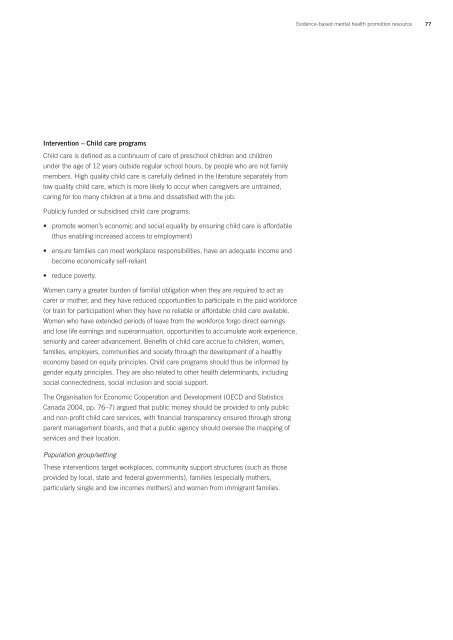Evidence-based mental health promotion resource - health.vic.gov.au
Evidence-based mental health promotion resource - health.vic.gov.au
Evidence-based mental health promotion resource - health.vic.gov.au
Create successful ePaper yourself
Turn your PDF publications into a flip-book with our unique Google optimized e-Paper software.
<strong>Evidence</strong>-<strong>based</strong> <strong>mental</strong> <strong>health</strong> <strong>promotion</strong> <strong>resource</strong>77Intervention – Child care programsChild care is defined as a continuum of care of preschool children and childrenunder the age of 12 years outside regular school hours, by people who are not familymembers. High quality child care is carefully defined in the literature separately fromlow quality child care, which is more likely to occur when caregivers are untrained,caring for too many children at a time and dissatisfied with the job.Publicly funded or subsidised child care programs:• promote women’s economic and social equality by ensuring child care is affordable(thus enabling increased access to employment)• ensure families can meet workplace responsibilities, have an adequate income andbecome economically self-reliant• reduce poverty.Women carry a greater burden of familial obligation when they are required to act ascarer or mother, and they have reduced opportunities to participate in the paid workforce(or train for participation) when they have no reliable or affordable child care available.Women who have extended periods of leave from the workforce forgo direct earningsand lose life earnings and superannuation, opportunities to accumulate work experience,seniority and career advancement. Benefits of child care accrue to children, women,families, employers, communities and society through the development of a <strong>health</strong>yeconomy <strong>based</strong> on equity principles. Child care programs should thus be informed bygender equity principles. They are also related to other <strong>health</strong> determinants, includingsocial connectedness, social inclusion and social support.The Organisation for Economic Cooperation and Development (OECD and StatisticsCanada 2004, pp. 76–7) argued that public money should be provided to only publicand non-profit child care ser<strong>vic</strong>es, with financial transparency ensured through strongparent management boards, and that a public agency should oversee the mapping ofser<strong>vic</strong>es and their location.Population group/settingThese interventions target workplaces, community support structures (such as thoseprovided by local, state and federal <strong>gov</strong>ernments), families (especially mothers,particularly single and low incomes mothers) and women from immigrant families.



